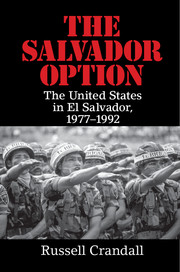Book contents
- Frontmatter
- Dedication
- Epigraph
- Contents
- List of Figures
- List of Organizations
- Acknowledgments
- 1 Introduction
- PART ONE EL SALVADOR IN THE COLD WAR
- PART TWO JIMMY CARTER
- PART THREE RONALD REAGAN
- PART FOUR GEORGE H. W. BUSH
- 39 Elusive Justice
- 40 Pessimism
- 41 Bush Arrives
- 42 Bush, Cristiani, and the 1989 Vote
- 43 Guerrilla Second Final Offensive, November 1989
- 44 Jesuit Killings
- 45 SAMs
- 46 United Nations and Peace
- 47 Demobilization
- PART FIVE POSTWAR
- Notes
- Bibliography
- Index
45 - SAMs
from PART FOUR - GEORGE H. W. BUSH
Published online by Cambridge University Press: 05 June 2016
- Frontmatter
- Dedication
- Epigraph
- Contents
- List of Figures
- List of Organizations
- Acknowledgments
- 1 Introduction
- PART ONE EL SALVADOR IN THE COLD WAR
- PART TWO JIMMY CARTER
- PART THREE RONALD REAGAN
- PART FOUR GEORGE H. W. BUSH
- 39 Elusive Justice
- 40 Pessimism
- 41 Bush Arrives
- 42 Bush, Cristiani, and the 1989 Vote
- 43 Guerrilla Second Final Offensive, November 1989
- 44 Jesuit Killings
- 45 SAMs
- 46 United Nations and Peace
- 47 Demobilization
- PART FIVE POSTWAR
- Notes
- Bibliography
- Index
Summary
We have to seek our own conception for the war. The war may be low intensity for the United States…but for us this is total conflict.
– General Juan Orlando Zepeda, Salvadoran Deputy Defense Minister, October 1988In truth, my government is not engaged, and has not been engaged in, the provision of arms or other supplies to either of the factions engaged in the civil war in El Salvador.
– Miguel D'Escoto, Foreign Minister of Nicaragua, April 21, 1984She's too much of a pacifist to agree to do it and she's too smart to let someone else do it.
– Reverend Debbie Roberts commenting on the charges against American Jennifer Casolo, December 1989On November 24, 1989, when the final offensive was still raging across El Salvador, Salvadoran police allegedly captured an FMLN gunrunner, Fausto Gallardo Valdez, who confessed to knowing of a weapons cache located in the walled courtyard of the house of American church worker Jennifer Casolo from Connecticut. Casolo had been working in El Salvador leading informational tours for Christian Education Seminars, a Texas-based ecumenical organization known for being nonpartisan. The authorities told the press that Gallardo did not name Casolo but instead described a foreign female that fit her description. The following night the police unearthed the trove of weapons and ammunition. The police initially claimed that the cache included 80,000 rounds of ammunition for assault rifles, but then cut the number to 22,000 along with 103 mortar grenades, 213 blocks of dynamite, 405 detonators, and 150 feet of slow-burning fuse.
Casolo was soon charged with terrorism and harboring arms and was held under a 90-day investigative statute. Casolo's lawyers, Ramsey Clark and Salvador Ibarra, contended that because she had only rented the house for six months and was frequently traveling that the weapons could have easily been buried without her knowledge. The case took another turn days later when the government released a 60-minute videotape taken during the raid showing police discovering a photograph of Casolo, a cassette of American folk singer Tracy Chapman, and various other materials buried along with the weapons.
- Type
- Chapter
- Information
- The Salvador OptionThe United States in El Salvador, 1977–1992, pp. 453 - 460Publisher: Cambridge University PressPrint publication year: 2016

